Honda GXV390, GXV340 Owner's Manual

INTRODUCTION
Thank you for purchasing a Honda engine. We want to help you to get the best results from your new engine and to operate it safely. This manual contains information on how to do that; please read it carefully before operating the engine. If a problem should arise, or if you have any questions about your engine, consult an authorized Honda servicing dealer.
All information in this publication is based on the latest product information available at the time of printing. Honda Motor Co., Ltd. reserves the right to make changes at any time without notice and without incurring any obligation. No part of this publication may be reproduced without written permission.
This manual should be considered a permanent part of the engine and should remain with the engine if resold.
Review the instructions provided with the equipment powered by this engine for any additional information regarding engine startup, shutdown, operation, adjustments or any special maintenance instructions.
United States, Puerto Rico, and U.S. Virgin Islands:
We suggest you read the warranty policy to fully understand its coverage and your responsibilities of ownership. The warranty policy is a separate document that should have been given to you by your dealer.
SAFETY MESSAGES
Your safety and the safety of others is very important. We have provided important safety messages in this manual and on the engine. Please read these messages carefully.
A safety message alerts you to potential hazards that could hurt you or others. Each safety message is preceded by a safety alert symbol  and one of three words, DANGER, WARNING, or CAUTION.
and one of three words, DANGER, WARNING, or CAUTION.
These signal words mean:
You WILL be KILLED or SERIOUSLY HURT if you don’t follow instructions.
You CAN be KILLED or SERIOUSLY
HURT if you don’t follow instructions.
You CAN be HURT if you don’t follow instructions.
Each message tells you what the hazard is, what can happen, and what you can do to avoid or reduce injury.
DAMAGE PREVENTION MESSAGES
You will also see other important messages that are preceded by the word NOTICE.
This word means:
Your engine or other property can be damaged if you don’t follow instructions.
The purpose of these messages is to help prevent damage to your engine, other property, or the environment.
 2005 Honda Motor Co., Ltd. All Rights Reserved
2005 Honda Motor Co., Ltd. All Rights Reserved
|
|
GXV340UT2·GXV390UT1 |
37Z5PA00 |
EM3 |
2005.08 |
00X37-Z5P-A000 |
|
PRINTED IN U.S. |
MANUEL DE L’UTILISATEUR |
ENGLISH |
OWNER’S MANUAL |
|
MANUAL DEL PROPIETARIO |
|
GXV340 · GXV390 |
|
|
FRANÇAIS |
The engine exhaust from this product |
ESPAÑOL |
|
|
contains chemicals known to the State of |
|
California to cause cancer, birth defects |
|
or other reproductive harm. |
|
CONTENTS |
|
INTRODUCTION....................... |
.1 |
SAFETY MESSAGES................ |
.1 |
SAFETY INFORMATION .......... |
.2 |
SAFETY LABEL LOCATION ..... |
.2 |
COMPONENT & CONTROL |
|
LOCATION ................................ |
.2 |
FEATURES................................ |
.3 |
BEFORE OPERATION |
|
CHECKS .................................... |
.3 |
OPERATION.............................. |
.4 |
SAFE OPERATING |
|
PRECAUTIONS ..................... |
.4 |
STARTING THE ENGINE ...... |
.4 |
STOPPING THE ENGINE ...... |
.5 |
SETTING ENGINE SPEED..... |
.6 |
SERVICING YOUR ENGINE ..... |
.7 |
THE IMPORTANCE OF |
|
MAINTENANCE .................... |
.7 |
MAINTENANCE SAFETY...... |
.7 |
SAFETY PRECAUTIONS....... |
.7 |
MAINTENANCE |
|
SCHEDULE............................ |
.7 |
REFUELING........................... |
.8 |
ENGINE OIL........................... |
.8 |
Recommended Oil ............ |
.8 |
Oil Level Check.................. |
.9 |
Oil Change......................... |
.9 |
AIR CLEANER....................... |
10 |
Inspection......................... |
10 |
Cleaning ........................... |
10 |
SPARK PLUG ....................... |
10 |
SPARK ARRESTER .............. |
11 |
HELPFUL TIPS & |
|
SUGGESTIONS ....................... |
11 |
STORING YOUR ENGINE.... |
11 |
TRANSPORTING ................. |
13 |
TAKING CARE OF |
|
UNEXPECTED PROBLEMS ..... |
13 |
TECHNICAL & CONSUMER |
|
INFORMATION........................ |
14 |
Serial Number Location ...... |
14 |
Battery Connections for |
|
Electric Starter ..................... |
14 |
Remote Control Linkage...... |
14 |
Carburetor Modifications for |
|
High Altitude Operation ...... |
14 |
Oxygenated Fuels................ |
15 |
Emission Control System |
|
Information .......................... |
15 |
Air Index............................... |
16 |
Specifications ...................... |
16 |
Tuneup Specifications......... |
16 |
Quick Reference |
|
Information .......................... |
17 |
Wiring Diagrams ................. |
17 |
CONSUMER INFORMATION..18 |
|
Distributor/Dealer Locator |
|
Information .......................... |
18 |
Customer Service |
|
Information .......................... |
18 |
ENGLISH |
1 |
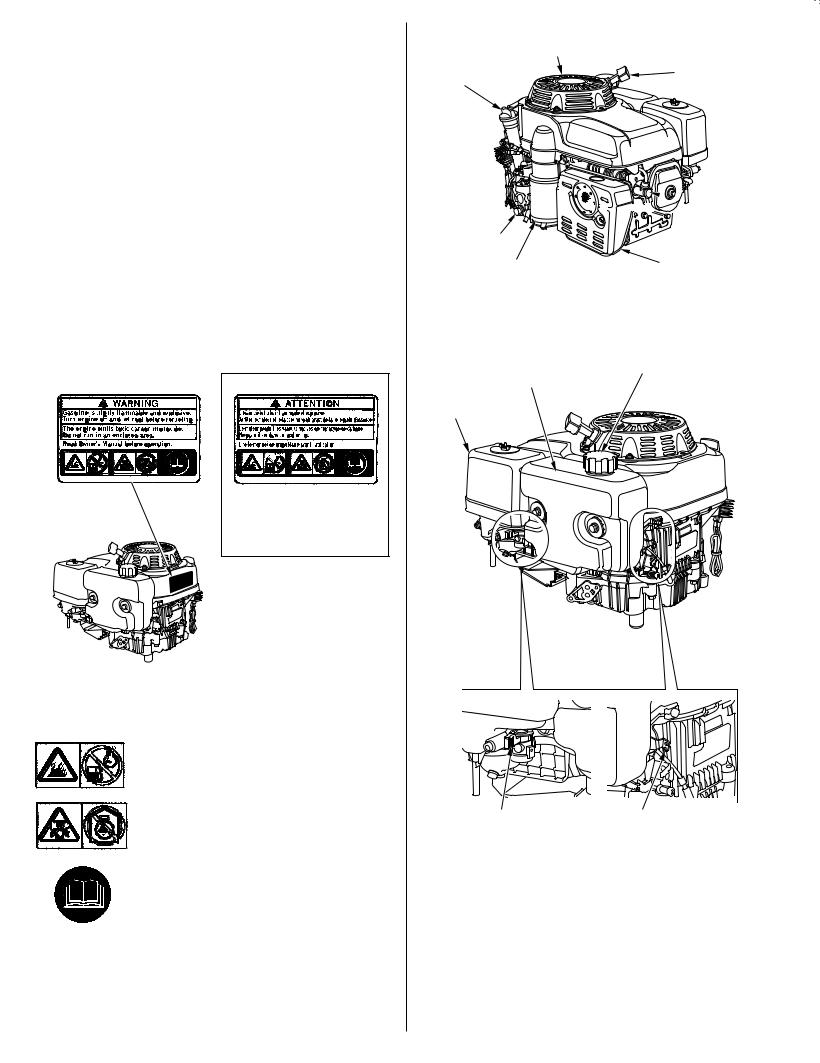
SAFETY INFORMATION
 Understand the operation of all controls and learn how to stop the engine quickly in case of emergency. Make sure the operator receives adequate instruction before operating the equipment.
Understand the operation of all controls and learn how to stop the engine quickly in case of emergency. Make sure the operator receives adequate instruction before operating the equipment.
 Do not allow children to operate the engine. Keep children and pets away from the area of operation.
Do not allow children to operate the engine. Keep children and pets away from the area of operation.
 Your engine’s exhaust contains poisonous carbon monoxide. Do not run the engine without adequate ventilation, and never run the engine indoors.
Your engine’s exhaust contains poisonous carbon monoxide. Do not run the engine without adequate ventilation, and never run the engine indoors.
 The engine and exhaust become very hot during operation. Keep the engine at least 1 meter (3 feet) away from buildings and other equipment during operation. Keep flammable materials away, and do not place anything on the engine while it is running.
The engine and exhaust become very hot during operation. Keep the engine at least 1 meter (3 feet) away from buildings and other equipment during operation. Keep flammable materials away, and do not place anything on the engine while it is running.
SAFETY LABEL LOCATION
This label warns you of potential hazards that can cause serious injury. Read it carefully.
If the label comes off or becomes hard to read, contact your Honda dealer for replacement.
For Canadian types only: French label comes with the engine.
Gasoline is highly flammable and explosive.
Turn engine off and let cool before refueling.
The engine emits toxic poisonous carbon monoxide gas. Do not run in an enclosed area.
Read Owner’s Manual before operation.
COMPONENT & CONTROL LOCATION
|
RECOIL STARTER |
OIL FILLER CAP/ |
STARTER GRIP |
DIPSTICK |
|


 SPARK PLUG
SPARK PLUG
OIL DRAIN PLUG
ELECTRIC STARTER |
MUFFLER |
(applicable types) |
|
FUEL FILLER CAP
FUEL TANK
AIR CLEANER
ENGINE CONTROL
FUEL VALVE LEVER |
CONTROL LEVER |
2 |
ENGLISH |
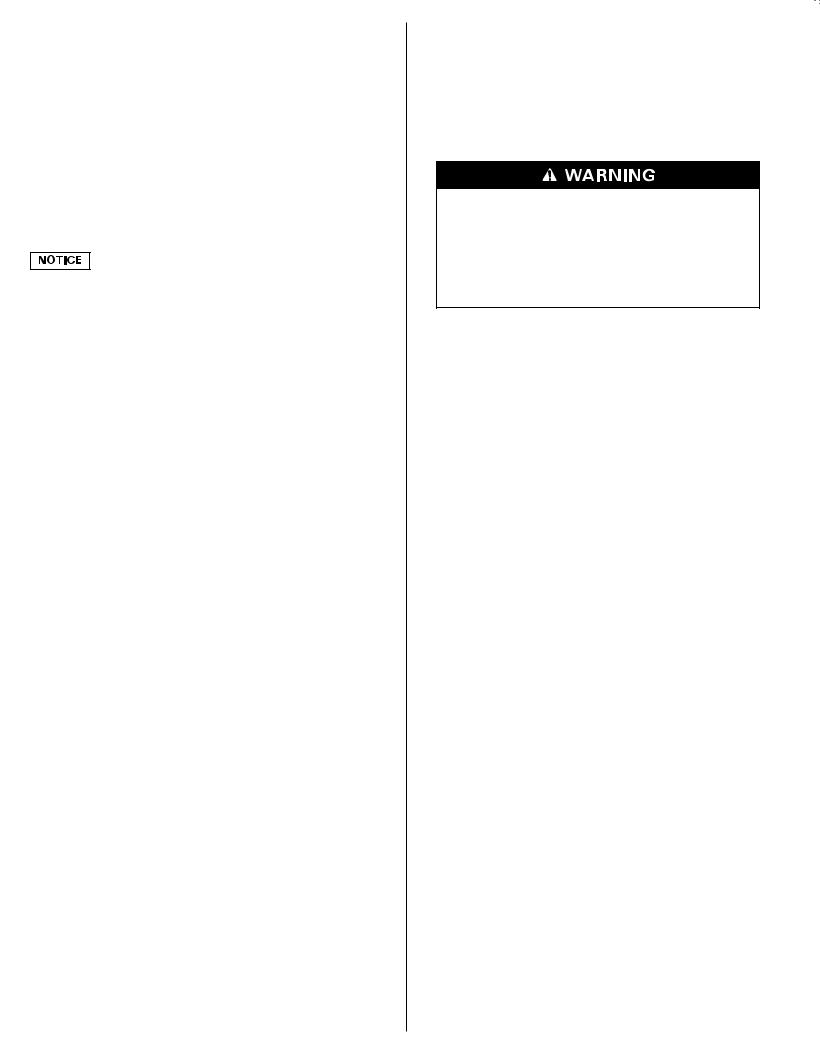
FEATURES
OIL ALERT SYSTEM (applicable types)
SYSTEM (applicable types)
The Oil Alert system is designed to prevent engine damage caused by an insufficient amount of oil in the crankcase. Before the oil level in the crankcase can fall below a safe limit, the Oil Alert
system is designed to prevent engine damage caused by an insufficient amount of oil in the crankcase. Before the oil level in the crankcase can fall below a safe limit, the Oil Alert system will sound a buzzer, warning you that oil needs to be added to the engine.
system will sound a buzzer, warning you that oil needs to be added to the engine.
The Oil Alert system is not designed to be used in place of checking the oil. Check the oil level prior to each use.
system is not designed to be used in place of checking the oil. Check the oil level prior to each use.
The ‘‘Oil Alert ’’ buzzer will arm you when engine oil needs to be added to the crankcase. If the buzzer sounds, stop the engine and add oil (see page 9 ).
’’ buzzer will arm you when engine oil needs to be added to the crankcase. If the buzzer sounds, stop the engine and add oil (see page 9 ).
The buzzer indicates insufficient oil. Running the engine with insufficient oil can cause serious engine damage.
BEFORE OPERATION CHECKS
IS YOUR ENGINE READY TO GO?
For your safety, and to maximize the service life of your equipment, it is very important to take a few moments before you operate the engine to check its condition. Be sure to take care of any problem you find, or have your servicing dealer correct it, before you operate the engine.
Improperly maintaining this engine, or failure to correct a problem before operation, can cause a malfunction in which you can be seriously hurt or killed.
Always perform a preoperation inspection before each operation, and correct any problem.
Before beginning your preoperation checks, be sure the engine is level and the engine switch is in the OFF position.
Always check the following items before you start the engine:
Check the General Condition of the Engine
1.Look around and underneath the engine for signs of oil or gasoline leaks.
2.Remove any excessive dirt or debris, especially around the muffler and recoil starter.
3.Look for signs of damage.
4.Check that all shields and covers are in place, and all nuts, bolts, and screws are tightened.
Check the Engine
1.Check the fuel level (see page 8 ). Starting with a full tank will help to eliminate or reduce operating interruptions for refueling.
2.Check the engine oil level (see page 9 ). Running the engine with a low oil level can cause engine damage.
The ‘‘Oil Alert ’’ buzzer (applicable types) will warn you when engine oil needs to be added to the crankcase. If the buzzer sounds, stop the engine and add oil.
’’ buzzer (applicable types) will warn you when engine oil needs to be added to the crankcase. If the buzzer sounds, stop the engine and add oil.
3.Check the air filter element (see page 10 ). A dirty air filter element will restrict air flow to the carburetor, reducing engine performance.
4.Check the equipment powered by this engine.
Review the instructions provided with the equipment powered by this engine for any precautions and procedures that should be followed before engine startup.
ENGLISH |
3 |

OPERATION
SAFE OPERATING PRECAUTIONS
Before operating the engine for the first time, please review the
SAFETY INFORMATION section on page 2 and the BEFORE OPERATION CHECKS on page 3 .
Carbon monoxide gas is toxic. Breathing it can cause unconsciousness and even kill you.
Avoid any areas or actions that expose you to carbon monoxide.
Review the instructions provided with the equipment powered by this engine for any safety precautions that should be observed with engine startup, shutdown or operation.
Control Lever
The control lever operates the engine switch, throttle, and choke.
OFF ––––––––Stop the engine by switching off the ignition system. All other control lever positions leave the ignition system switched on.
MIN. –––––––For running the engine at idle speed.
MAX. ––––––For restarting a warm engine, and for running the engine at maxinum speed.
CHOKE–––––Enriches the fuel mixture for starting a cold engine.
The control lever shown here will be connected to a remote control on the equipment powered by this engine. Refer to the instructions provided with that equipment for remote control information.
CHOKE
MAX.
MIN.
OFF
CONTROL LEVER
STARTING THE ENGINE
1. Move the fuel valve lever to the ON position.
FUEL VALVE LEVER
ON
2. To start a cold engine, move the control lever to the CHOKE position.
CONTROL LEVER
CHOKE

 MAX.
MAX.
To restart a warm engine, leave the control lever in the MAX. position.
The control lever shown here will be connected to a remote control on the equipment powered by this engine. Refer to the instructions provided with that equipment for remote control information.
3.Turn the engine switch to the ON position.
There may be a remote engine switch mounted on the equipment powered by this engine. Refer to the instructions provided with the equipment for remote control information.
4 |
ENGLISH |
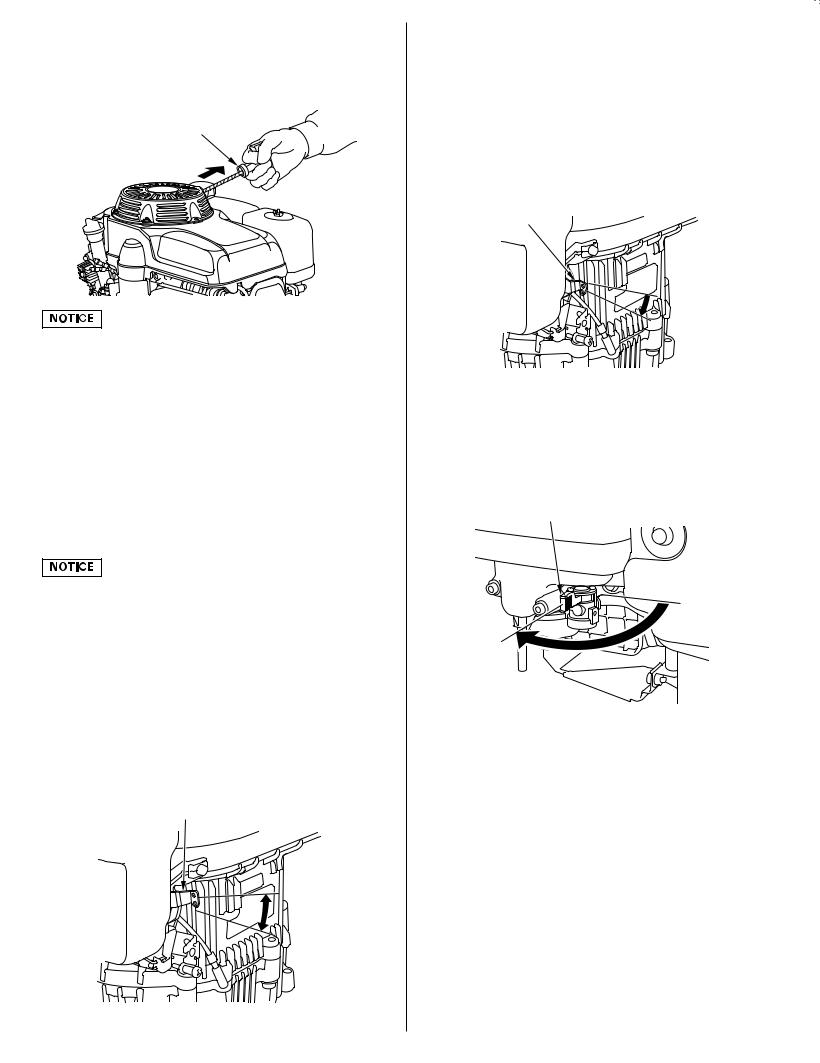
4.Operate the starter. RECOIL STARTER
Pull the starter grip lightly until you feel resistance, then pull briskly. Return the starter grip gently.
STARTER GRIP
Do not allow the starter grip to snap back against the engine. Return it gently to prevent damage to the starter.
ELECTRIC STARTER (applicable types):
The electric starter will be connected to a remote control on the equipment powered by this engine. Refer to the instructions provided with the equipment for remote control information.
Turn the engine switch key to the START position, and hold it there until the engine starts.
If the engine fails to start within 5 seconds, release the engine switch key, and wait at least 10 seconds before operating the starter again.
Using the electric starter for more than 5 seconds at a time will overheat the starter motor and can damage it.
When the engine starts, release the engine switch key, allowing it to return to the ON position.
5.If the control lever was moved to the CHOKE position to start the engine, gradually move it to the MAX. or MIN. position as the engine warms up.
The control lever shown here will be connected to a remote control on the equipment powered by this engine. Refer to the instructions provided with that equipment for remote control information.
CONTROL LEVER
MAX.
MIN.
STOPPING THE ENGINE
To stop the engine in an emergency, simply move the control lever to the OFF position. Under normal conditions, use the following procedure.
1. Move the control lever to the OFF position.
The control lever shown here will be connected to a remote control on the equipment powered by this engine. Refer to the instructions provided with the equipment for remote control information.
CONTROL LEVER
OFF
2.Turn the engine switch to the OFF position.
There may be a remote engine switch mounted on the equipment powered by this engine. Refer to the instructions provided with the equipment for remote control information.
3.Turn the fuel valve lever to the OFF position.
FUEL VALVE LEVER
OFF
ENGLISH |
5 |
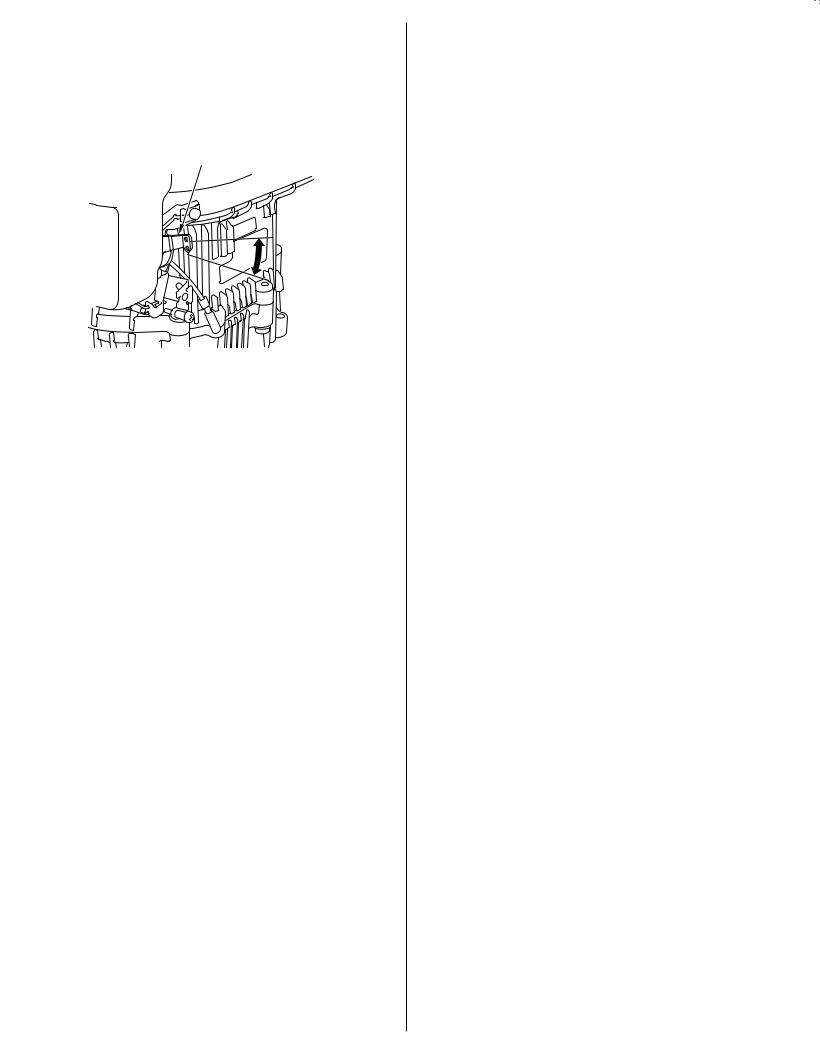
SETTING ENGINE SPEED
Position the control lever for the desired engine speed.
The control lever shown here will be connected to a remote control on the equipment powered by this engine. Refer to the instructions provided with that equipment for remote control information and engine speed recommendations.
CONTROL LEVER
MAX.
MIN.
6 |
ENGLISH |
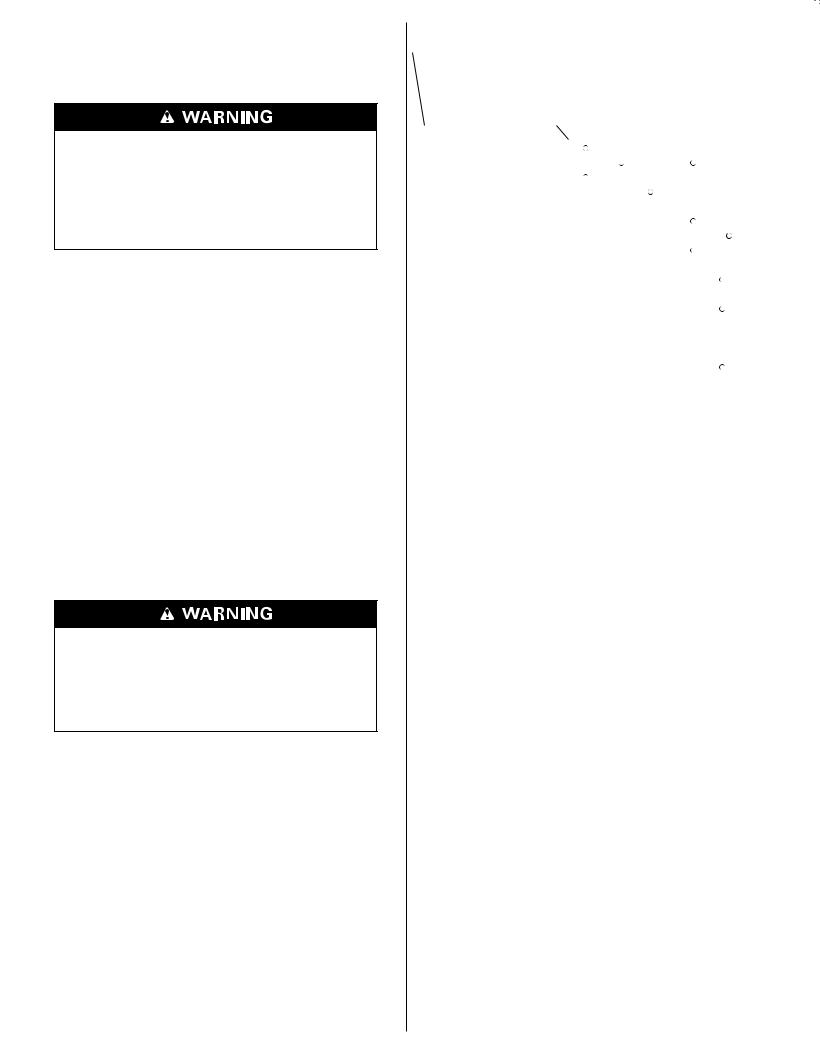
SERVICING YOUR ENGINE
THE IMPORTANCE OF MAINTENANCE
Good maintenance is essential for safe, economical and troublefree operation. It will also help reduce pollution.
Improper maintenance, or failure to correct a problem before operation, can cause a malfunction in which you can be seriously hurt or killed.
Always follow the inspection and maintenance recommendations and schedules in this owner’s manual.
To help you properly care for your engine, the following pages include a maintenance schedule, routine inspection procedures, and simple maintenance procedures using basic hand tools. Other service tasks that are more difficult, or require special tools, are best handled by professionals and are normally performed by a Honda technician or other qualified mechanic.
The maintenance schedule applies to normal operating conditions. If you operate your engine under severe conditions, such as sustained high-load or high-temperature operation, or use in unusually wet or dusty conditions, consult your servicing dealer for recommendations applicable to your individual needs and use.
Maintenance, replacement, or repair of the emission control devices and systems may be performed by any engine repair establishment or individual, using parts that are ‘‘certified’’ to EPA standards.
MAINTENANCE SAFETY
Some of the most important safety precautions follow. However, we cannot warn you of every conceivable hazard that can arise in performing maintenance. Only you can decide whether or not you should perform a given task.
Failure to properly follow maintenance instructions and precautions can cause you to be seriously hurt or killed.
Always follow the procedures and precautions in this owner’s manual.
SAFETY PRECAUTIONS
 Make sure the engine is off before you begin any maintenance or repairs. This will eliminate several potential hazards:
Make sure the engine is off before you begin any maintenance or repairs. This will eliminate several potential hazards:
Carbon monoxide poisoning from engine exhaust.
Be sure there is adequate ventilation whenever you operate the engine.
Burns from hot parts.
Let the engine and exhaust system cool before touching.
Injury from moving parts.
Do not run the engine unless instructed to do so.
 Read the instructions before you begin, and make sure you have the tools and skills required.
Read the instructions before you begin, and make sure you have the tools and skills required.
 To reduce the possibility of fire or explosion, be careful when working around gasoline. Use only a nonflammable solvent, not gasoline, to clean parts. Keep cigarettes, sparks and flames away from all fuel related parts.
To reduce the possibility of fire or explosion, be careful when working around gasoline. Use only a nonflammable solvent, not gasoline, to clean parts. Keep cigarettes, sparks and flames away from all fuel related parts.
Remember that an authorized Honda servicing dealer knows your engine best and is fully equipped to maintain and repair it.
To ensure the best quality and reliability, use only new genuine Honda parts or their equivalents for repair and replacement.
MAINTENANCE SCHEDULE
|
REGULAR SERVICE PERIOD (3) |
Each |
First |
Every 3 |
Every 6 |
Every |
Refer |
||
|
Perform at every |
|
|
Use |
Month |
Months |
Months |
Year |
to |
|
indicated month or |
|
or |
or |
or |
or |
Page |
||
|
operating hour interval, |
|
20 Hrs |
50 Hrs |
100 Hrs |
300 Hrs |
|
||
|
whichever comes first. |
|
|
|
|
|
|
||
|
ITEM |
|
|
|
|
|
|
|
|
|
Engine oil |
Check level |
|
|
|
|
|
9 |
|
|
|
Change |
|
|
|
|
|
9 |
|
|
Air filter |
Check |
|
|
|
|
|
10 |
|
|
|
Clean |
|
|
(1) |
|
|
|
|
|
|
Replace |
|
|
|
|
|
|
|
|
Spark plug |
Check-adjust |
|
|
|
|
|
10 |
|
|
|
Replace |
|
|
|
|
|
|
|
|
Spark arrester |
Clean |
|
|
|
|
|
11 |
|
|
(applicable types) |
|
|
|
|
|
|
|
|
|
Idle speed |
Check-adjust |
|
|
|
|
(2) |
Shop |
|
|
|
|
|
|
|
|
|
|
manual |
|
Valve clearance |
Check-adjust |
|
|
|
|
(2) |
Shop |
|
|
|
|
|
|
|
|
|
|
manual |
|
Combustion |
Clean |
|
After every 250 Hrs. (2) |
|
Shop |
|||
|
chamber |
|
|
|
|
|
|
|
manual |
|
Fuel tank & |
Clean |
|
|
|
|
(2) |
Shop |
|
|
filter |
|
|
|
|
|
|
|
manual |
|
Fuel tube |
Check |
|
Every 2 years |
|
Shop |
|||
|
|
|
|
|
(Replace if necessary) (2) |
|
manual |
||
Replace paper element type only.
(1)Service more frequently when used in dusty areas.
(2)These items should be serviced by your servicing dealer, unless you have the proper tools and are mechanically proficient. Refer to Honda shop manual for service procedures.
(3)For commercial use, log hours of operation to determine proper maintenance intervals.
Failure to follow this maintenance schedule could result in nonwarrantable failures.
ENGLISH |
7 |
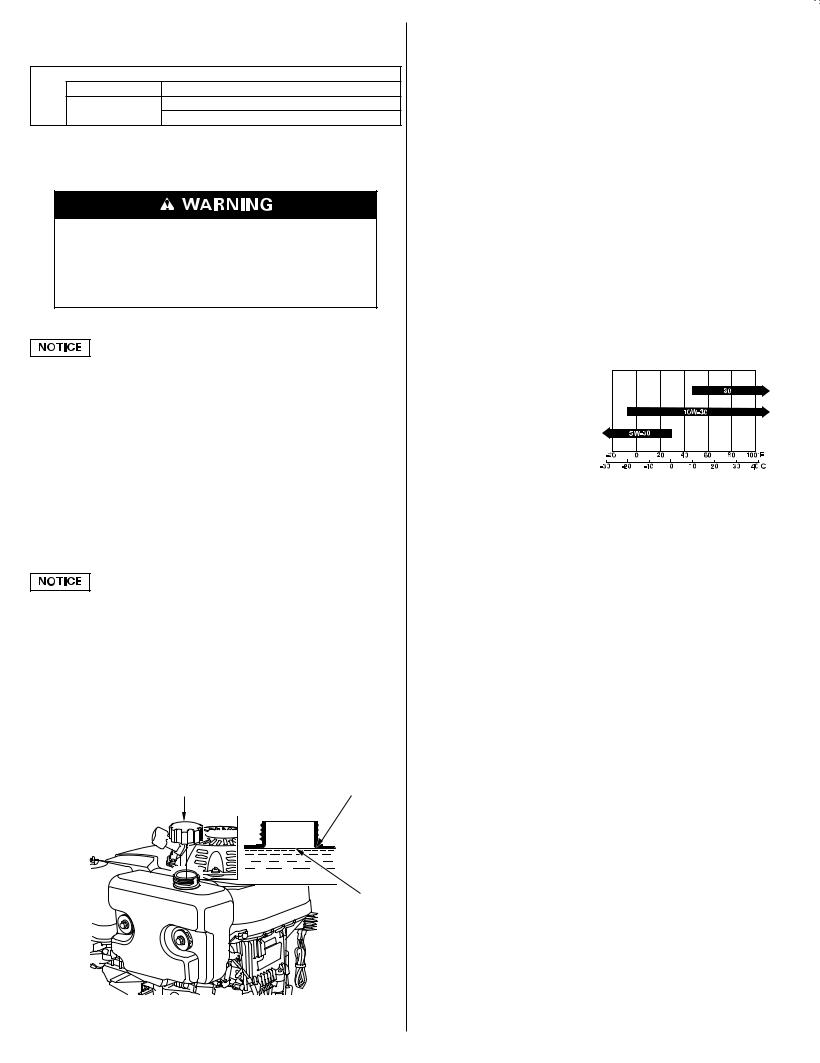
REFUELING
Recommended Fuel
Unleaded gasoline
U.S. |
Pump octane rating 86 or higher |
Except U.S. |
Research octane rating 91 or higher |
|
Pump octane rating 86 or higher |
This engine is certified to operate on unleaded gasoline. Unleaded gasoline produces fewer engine and spark plug deposits and extends exhaust system life.
Gasoline is highly flammable and explosive, and you can be burned or seriously injured when refueling.
 Stop engine and keep heat, sparks, and flame away.
Stop engine and keep heat, sparks, and flame away.
 Refuel only outdoors.
Refuel only outdoors.  Wipe up spills immediately.
Wipe up spills immediately.
Fuel can damage paint and some types of plastic. Be careful not to spill fuel when filling your fuel tank. Damage caused by spilled fuel is not covered under the Distributor’s Limited Warranty.
Never use stale or contaminated gasoline or oil/gasoline mixture. Avoid getting dirt or water in the fuel tank.
Occasionally you may hear a light ‘‘spark knock’’ or ‘‘pinging’’ (metallic rapping noise) while operating under heavy loads. This is no cause for concern.
If spark knock or pinging occurs at a steady engine speed, under normal load, change brands of gasoline. If spark knock or pinging persists, see an authorized Honda servicing dealer.
Running the engine with persistent spark knock or pinging can cause engine damage.
Running the engine with persistent spark knock or pinging is considered misuse, and the Distributor’s Limited Warranty does not cover parts damaged by misuse.
1.With the engine stopped and on a level surface, remove the fuel filler cap and check the fuel level.
2.Refill the tank if the fuel level is low. Do not fill above the upper limit of the fuel tank. Wipe up spilled fuel before starting the
engine.
FUEL FILLER CAP |
FILLER NECK |
UPPER LIMIT
Refuel in a well-ventilated area before starting the engine. If the engine has been running, allow it to cool. Refuel carefully to avoid spilling fuel. Do not fill the fuel tank completely. Fill tank to the upper limit level below the filler neck of the fuel tank to allow for fuel expansion. It may be necessary to lower the fuel level depending on operating conditions. After refueling, tighten the fuel filler cap securely.
Never refuel the engine inside a building where gasoline fumes may reach flames or sparks. Keep gasoline away from appliance pilot lights, barbecues, electric appliances, power tools, etc.
Spilled fuel is not only a fire hazard, it causes environmental damage. Wipe up spills immediately.
For information regarding oxygenated fuels, please refer to page 15 .
ENGINE OIL
Oil is a major factor affecting performance and service life. Use 4-stroke automotive detergent oil.
SAE Viscosity Grades
Recommended Oil |
|
Use 4-stroke motor oil that |
|
meets or exceeds the |
|
requirements for API service |
|
classification SJ, SL, or |
|
equivalent. Always check the |
|
API service label on the oil |
|
container to be sure it includes |
AMBIENT TEMPERATURE |
the letters SJ, SL, or equivalent. |
|
SAE 10W-30 is recommended for general use. Other viscosities shown in the chart may be used when the average temperature in your area is within the indicated range.
8 |
ENGLISH |

Oil Level Check
Check the engine oil level with the engine stopped and in a level position.
1.Remove the oil filler cap/dipstick and wipe it clean.
2.Insert and remove the oil filler cap/dipstick without screwing it into the oil filler neck. Check the oil level shown on the dipstick.
3.If the oil level is near or below the lower limit mark on the dipstick, fill with the recommended oil (see page 8 ) to the upper limit mark. Do not overfill.
4.Screw in the filler cap/dipstick securely.
OIL FILLER NECK |
OIL FILLER CAP/ |
|
DIPSTICK |
UPPER LIMIT
LOWER LIMIT
Running the engine with a low oil level can cause engine damage.
The ‘‘Oil Alert ’’ buzzer (applicable types) will warn you when engine oil needs to be added to the crankcase. If the buzzer sounds, stop the engine and add oil.
’’ buzzer (applicable types) will warn you when engine oil needs to be added to the crankcase. If the buzzer sounds, stop the engine and add oil.
Oil Change
Drain the used oil when the engine is warm. Warm oil drains quickly and completely.
1.Place a suitable container below the engine to catch the used oil, then remove the oil filler cap/dipstick, oil drain plug and washer.
2.Allow the used oil to drain completely, then reinstall the oil drain plug and new washer, and tighten the oil drain plug securely.
Please dispose of used motor oil in a manner that is compatible with the environment. We suggest you take used oil in a sealed container to your local recycling center or service station for reclamation. Do not throw it in the trash, pour it on the ground, or down a drain.
3.With the engine in a level position, fill to the upper limit mark on the dipstick with the recommended oil (see page 8 ).
Running the engine with a low oil level can cause engine damage.
The ‘‘Oil Alert ’’ buzzer (applicable types) will warn you when engine oil needs to be added to the crankcase. If the buzzer sounds, stop the engine and add oil.
’’ buzzer (applicable types) will warn you when engine oil needs to be added to the crankcase. If the buzzer sounds, stop the engine and add oil.
4. Screw in the oil filler cap/dipstick securely.
OIL FILLER CAP/DIPSTICK
SEALING |
UPPER |
|
WASHER |
||
LIMIT |
||
|
||
OIL DRAIN |
LOWER |
|
PLUG |
||
LIMIT |
||
|
ENGLISH |
9 |

AIR CLEANER
A dirty air cleaner will restrict air flow to the carburetor, reducing engine performance. If you operate the engine in very dusty areas, clean the air filter more often than specified in the MAINTENANCE SCHEDULE.
Operating the engine without an air filter, or with a damaged air filter, will allow dirt to enter the engine, causing rapid engine wear. This type of damage is not covered by the Distributor’s Limited Warranty.
Inspection
Remove the air cleaner cover and inspect the filter elements. Clean or replace dirty filter elements. Always replace damaged filter elements.
Cleaning
1.Remove the wing nut from the air cleaner cover, and remove the cover.
2.Remove the air filter elements.
3.Remove the foam air filter element from the paper air filter element.
4.Inspect both air filter elements, and replace them if they are damaged. Always replace the paper air filter element at the scheduled interval (see page 7 ).
 WING NUT
WING NUT
 AIR CLEANER
AIR CLEANER
COVER
PAPER AIR
FILTER
ELEMENT

 FOAM AIR FILTER ELEMENT
FOAM AIR FILTER ELEMENT
 AIR CLEANER
AIR CLEANER
BASE
5.Clean the air filter elements if they are to be reused.
Paper air filter element: Tap the filter element several times on a hard surface to remove dirt, or blow compressed air [not exceeding 207 kPa (2.1 kgf/cm , 30 psi)] through the filter element from the inside. Never try to brush off dirt; brushing will force dirt into the fibers.
, 30 psi)] through the filter element from the inside. Never try to brush off dirt; brushing will force dirt into the fibers.
Foam air filter element: Clean in warm soapy water, rinse, and allow to dry thoroughly. Or clean in nonflammable solvent and allow to dry. Dip the filter element in clean engine oil, then squeeze out all excess oil. The engine will smoke when started if too much oil is left in the foam.
6.Wipe dirt from the inside of the air cleaner base and cover, using a moist rag. Be careful to prevent dirt from entering the air duct that leads to the carburetor.
7.Place the foam air filter element over the paper element, and reinstall the assembled air filter.
8.Install the air cleaner cover, and tighten the wing nut securely.
SPARK PLUG
Recommended Spark Plugs: BPR5ES (NGK)
W16EPR-U (DENSO)
The recommended spark plug is the correct heat range for normal engine operating temperatures.
An incorrect spark plug can cause engine damage.
For good performance, the spark plug must be properly gapped and free of deposits.
1.Disconnect the spark plug cap, and remove any dirt from around the spark plug area.
2.Remove the spark plug with a 13/16-inch spark plug wrench.
3.Inspect the spark plug. Replace it if damaged, badly fouled, if the sealing washer is in poor condition, or if the electrode is worn.
SPARK PLUG CAP
SPARK PLUG WRENCH
SIDE ELECTRODE
4.Measure the spark plug electrode gap with a wiretype feeler gauge. Correct the gap, if necessary, by carefully bending the side electrode. The gap should be:
0.70 0.80 mm (0.028 0.031 in)
5.Install the spark plug carefully, by hand, to avoid crossthreading.
0.70 0.80 mm
(0.028 0.031 in)

 SEALING WASHER
SEALING WASHER
6.After the spark plug is seated, tighten with a 13/16-inch spark plug wrench to compress the sealing washer.
7.When installing a new spark plug, tighten 1/2 turn after the spark plug seats to compress the washer.
8.When reinstalling the original spark plug, tighten 1/8 1/4 turn after the spark plug seats to compress the washer.
A loose spark plug can overheat and damage the engine. Overtightening the spark plug can damage the threads in the cylinder head.
9.Attach the spark plug cap to the spark plug.
10 |
ENGLISH |
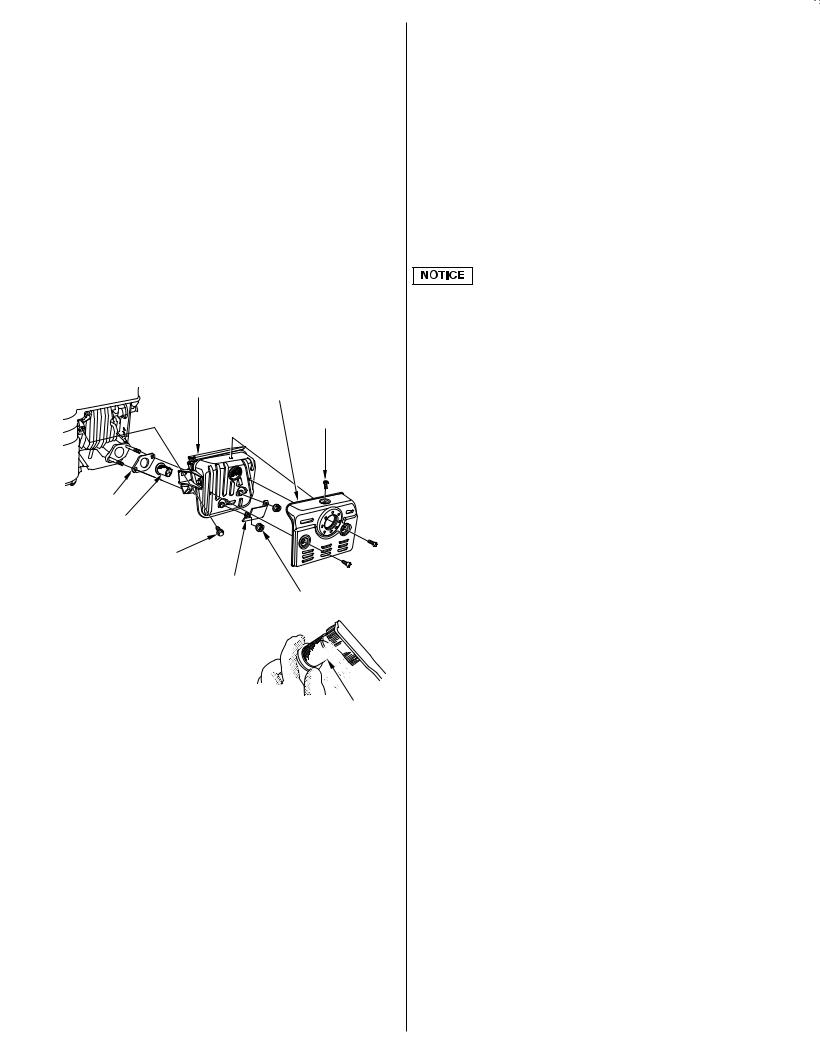
SPARK ARRESTER (applicable types)
The spark arrester may be standard or an optional part, depending on the engine type. In some areas, it is illegal to operate an engine without a spark arrester. Check local laws and regulations. A spark arrester is available from authorized Honda servicing dealers.
The spark arrester must be serviced every 100 hours to keep it functioning as designed.
If the engine has been running, the muffler will be hot. Allow it to cool before servicing the spark arrester.
Spark Arrester Removal
1.Remove the three 5 mm screws from the muffler protector.
2.Remove the 8 mm bolt and the two 8 mm nuts, and remove the muffler protector, identification plate, muffler and gasket from the cylinder.
3.Remove the spark arrester from the muffler (take care not to damage the wire mesh).
MUFFLER |
MUFFLER PROTECTOR |
5 mm SCREW (3)
GASKET 
SPARK ARRESTER
8 mm BOLT 
IDENTIFICATION PLATE
|
8 mm NUT (2) |
Spark Arrester Cleaning & Inspection |
|
1. Use a brush to remove carbon |
|
deposits from the spark arrester |
|
screen. Be careful not to damage |
|
the screen. Replace the spark |
SPARK ARRESTER |
arrester if it has breaks or holes. |
SCREEN |
2.Install the gasket, spark arrester, muffler, identification plate, and muffler protector in reverse order of removal.
HELPFUL TIPS & SUGGESTIONS
STORING YOUR ENGINE
Storage Preparation
Proper storage preparation is essential for keeping your engine trouble-free and looking good. The following steps will help to keep rust and corrosion from impairing your engine’s function and appearance, and will make the engine easier to start when you use it again.
Cleaning
If the engine has been running, allow it to cool for at least half an hour before cleaning. Clean all exterior surfaces, touch up any damaged paint, and coat other areas that may rust with a light film of oil.
Using a garden hose or pressure washing equipment can force water into the air cleaner or muffler opening. Water in the air cleaner will soak the air filter, and water that passes through the air filter or muffler can enter the cylinder, causing damage.
Fuel
Gasoline will oxidize and deteriorate in storage. Deteriorated gasoline will cause hard starting, and it leaves gum deposits that clog the fuel system. If the gasoline in your engine deteriorates during storage, you may need to have the carburetor, and other fuel system components, serviced or replaced.
The length of time that gasoline can be left in your fuel tank and carburetor without causing functional problems will vary with such factors as gasoline blend, your storage temperatures, and whether the fuel tank is partially or completely filled. The air in a partially filled fuel tank promotes fuel deterioration. Very warm storage temperatures accelerate fuel deterioration. Fuel problems may occur within a few months, or even less if the gasoline was not fresh when you filled the fuel tank.
Fuel system damage or engine performance problems resulting from neglected storage preparation are not covered under the
Distributor’s Limited Warranty.
You can extend fuel storage life by adding a gasoline stabilizer that is formulated for that purpose, or you can avoid fuel deterioration problems by draining the fuel tank and carburetor.
ENGLISH |
11 |
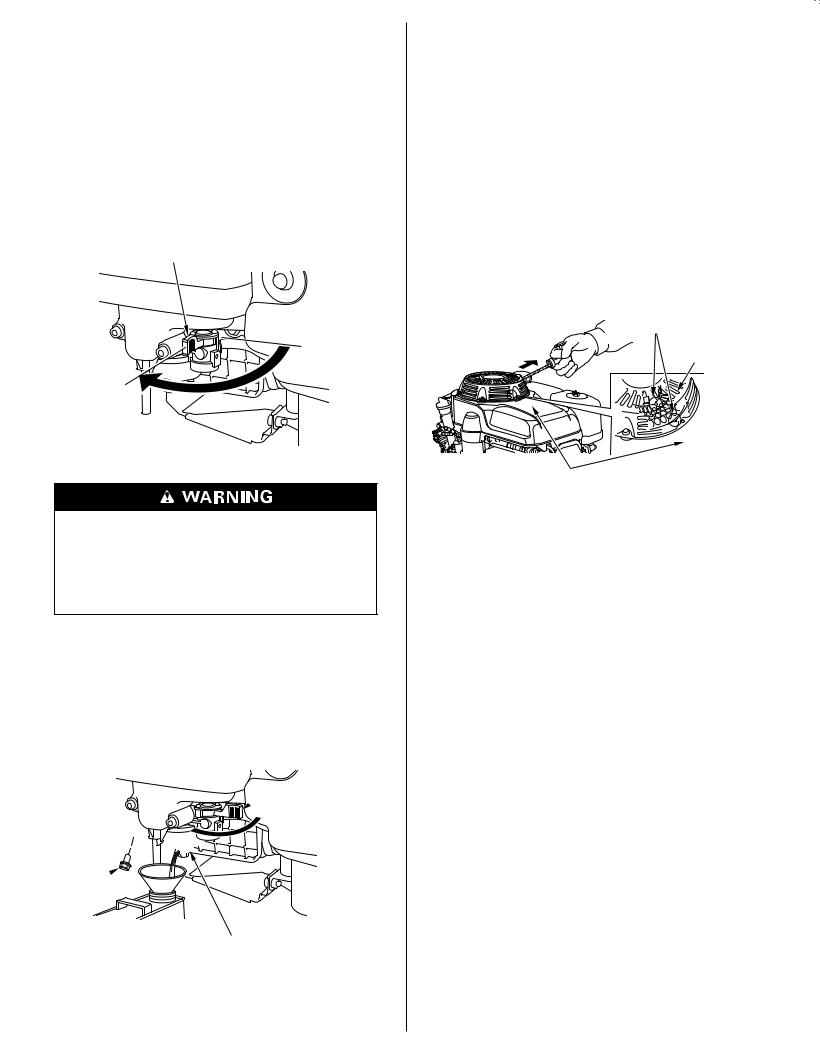
Adding a Gasoline Stabilizer to Extend Fuel Storage Life
When adding a gasoline stabilizer, fill the fuel tank with fresh gasoline. If only partially filled, air in the tank will promote fuel deterioration during storage. If you keep a container of gasoline for refueling, be sure that it contains only fresh gasoline.
1.Add gasoline stabilizer following the manufacturer’s instructions.
2.After adding a gasoline stabilizer, run the engine outdoors for 10 minutes to be sure that treated gasoline has replaced the untreated gasoline in the carburetor.
3.Stop the engine, and move the fuel valve lever to the OFF position.
FUEL VALVE LEVER
OFF
Draining the Fuel Tank and Carburetor
Gasoline is highly flammable and explosive, and you can be burned or seriously injured when handling fuel.
 Stop engine and keep heat, sparks, and flame away.
Stop engine and keep heat, sparks, and flame away.
 Handle fuel only outdoors.
Handle fuel only outdoors.  Wipe up spills immediately.
Wipe up spills immediately.
1.Place an approved gasoline container below the carburetor, and use a funnel to avoid spilling fuel.
2.Remove the drain bolt and gasket, and drain the carburetor bowl fuel into an approved gasoline container.
3.Move the fuel valve lever to the ON position. This will allow the fuel tank to drain through the carburetor bowl.
 FUEL VALVE LEVER
FUEL VALVE LEVER
 ON
ON
GASKET 


DRAIN BOLT 
CARBURETOR BOWL
4.After draining the carburetor bowl and fuel tank, install the drain bolt and gasket and tighten securely.
Engine Oil
1.Change the engine oil (see page 9 ).
2.Remove the spark plug (see page 10 ).
3.Pour a tablespoon 5 10 cm (5 10 cc) of clean engine oil into the cylinder.
(5 10 cc) of clean engine oil into the cylinder.
4.Pull the starter rope several times to distribute the oil in the cylinder.
5.Reinstall the spark plug.
6.Pull the starter rope slowly until resistance is felt.
(At this time the index mark on the cooling fan aligns with the index mark on the fan cover).
This will close the valves so moisture cannot enter the engine cylinder. Return the starter rope gently.
INDEX MARKS
COOLING FAN
FAN COVER
Storage Precautions
If your engine will be stored with gasoline in the fuel tank and carburetor, it is important to reduce the hazard of gasoline vapor ignition. Select a well-ventilated storage area away from any appliance that operates with a flame, such as a furnace, water heater, or clothes dryer. Also avoid any area with a sparkproducing electric motor, or where power tools are operated.
If possible, avoid storage areas with high humidity, because that promotes rust and corrosion.
Unless all fuel has been drained from the fuel tank, leave the fuel valve lever in the OFF position to reduce the possibility of fuel leakage.
Position the equipment so the engine is level. Tilting can cause fuel or oil leakage.
With the engine and exhaust system cool, cover the engine to keep out dust. A hot engine and exhaust system can ignite or melt some materials. Do not use sheet plastic as a dust cover. A nonporous cover will trap moisture around the engine, promoting rust and corrosion.
If equipped with a battery for electric starter types, recharge the battery once a month while the engine is in storage.
This will help to extend the service life of the battery.
12 |
ENGLISH |

Removal from Storage
Check your engine as described in the BEFORE OPERATION CHECKS section of this manual (see page 3 ).
If the fuel was drained during storage preparation, fill the tank with fresh gasoline. If you keep a container of gasoline for refueling, be sure it contains only fresh gasoline. Gasoline oxidizes and deteriorates over time, causing hard starting.
If the cylinder was coated with oil during storage preparation, the engine will smoke briefly at startup. This is normal.
TRANSPORTING
If the engine has been running, allow it to cool for at least 15 minutes before loading the engine-powered equipment on the transport vehicle. A hot engine and exhaust system can burn you and can ignite some materials.
Keep the engine level when transporting to reduce the possibility of fuel leakage. Turn the fuel valve to the OFF position (see
page 5 ).
TAKING CARE OF UNEXPECTED PROBLEMS
ENGINE WILL |
Possible Cause |
Correction |
NOT START |
|
|
1. Electric |
Battery |
Recharge battery. |
starting |
discharged. |
|
(applicable |
|
|
types): |
Fuse burnt out. |
Replace fuse. |
Check battery |
|
|
and fuse. |
|
|
2. Check control |
Fuel valve OFF. |
Move lever to ON |
positions. |
|
position. |
|
Choke open. |
Move control lever |
|
|
to CHOKE position |
|
|
unless the engine |
|
|
is warm. |
|
Engine switch |
Turn engine switch |
|
OFF. (if |
to ON position or |
|
equipped) |
move the throttle |
|
|
control away from |
|
|
the OFF position. |
3. Check engine |
Engine oil level |
Fill with the |
oil level. |
low (Oil Alert |
recommended oil |
|
types). |
to the proper level |
|
|
(p. 9). |
4. Check fuel. |
Out of fuel. |
Refuel (p. 8). |
|
Bad fuel; engine |
Drain fuel tank and |
|
stored without |
carburetor (p.12 ). |
|
treating or |
Refuel with fresh |
|
draining |
gasoline (p. 8 ). |
|
gasoline, or |
|
|
refueled with |
|
|
bad gasoline. |
|
5. Remove and |
Spark plug faulty, |
Gap or replace |
inspect spark |
fouled, or |
spark plug (p.10 ). |
plug. |
improperly |
|
|
gapped. |
|
|
Spark plug wet |
Dry and reinstall |
|
with fuel |
spark plug. Start |
|
(flooded engine). |
engine with control |
|
|
lever in MAX. |
|
|
position. |
6. Take engine to |
Fuel filter |
Replace or repair |
an authorized |
restricted, |
faulty components |
Honda |
carburetor |
as necessary. |
servicing |
malfunction, |
|
dealer, or refer |
ignition |
|
to shop |
malfunction, |
|
manual. |
valves stuck, etc. |
|
ENGINE LACKS |
Possible Cause |
Correction |
POWER |
|
|
1. Check air filter. |
Filter element(s) |
Clean or replace |
|
restricted. |
filter element(s) |
|
|
(p.10 ). |
2. Check fuel. |
Bad fuel; engine |
Drain fuel tank and |
|
stored without |
carburetor (p.10 ). |
|
treating or |
Refuel with fresh |
|
draining |
gasoline (p. 8 ). |
|
gasoline, or |
|
|
refueled with |
|
|
bad gasoline. |
|
3. Take engine to |
Fuel filter |
Replace or repair |
an authorized |
restricted, |
faulty components |
Honda |
carburetor |
as necessary. |
servicing |
malfunction, |
|
dealer, or refer |
ignition |
|
to shop |
malfunction, |
|
manual. |
valves stuck, etc. |
|
ENGLISH |
13 |

TECHNICAL & CONSUMER INFORMATION
TECHNICAL INFORMATION
Serial Number Location
Record the engine serial number, type and purchase date in the space below. You will need this information when ordering parts and when making technical or warranty inquiries.
ENGINE SERIAL NUMBER &
ENGINE TYPE LOCATION
Engine serial number: __ __ __ __ __ __ __ __ __ __ __
Engine type: ___ ___ ___ ___
Date Purchased: ______ / ______ / ______
Battery Connections for Electric Starter(applicable types)
Use a 12-volt battery with an ampere-hour rating of at least 18 Ah.
Be careful not to connect the battery in reverse polarity, as this will short circuit the battery charging system. Always connect the positive ( ) battery cable to the battery terminal before connecting the negative ( ) battery cable, so your tools cannot cause a short circuit if they touch a grounded part while tightening the positive ( ) battery cable end.
A battery can explode if you do not follow the correct procedure, seriously injuring anyone nearby.
Keep all sparks, open flames, and smoking materials away from the battery.
1.Connect the battery positive ( ) cable to the starter solenoid terminal as shown.
2.Connect the battery negative ( ) cable to an engine mounting bolt, frame bolt, or other good engine ground connection.
3.Connect the battery positive ( ) cable to the battery positive ( ) terminal as shown.
4.Connect the battery negative ( ) cable to the battery negative ( ) terminal as shown.
5.Coat the terminals and cable ends with grease.
NEGATIVE ( ) BATTERY CABLE POSITIVE ( ) BATTERY CABLE
STARTER SOLENOID
Remote Control Linkage
The control is provided with a hole for cable attachment. Install a solid wire cable as shown below. Do not use braided wire cable.
SOLID WIRE CABLE
 CABLE CLAMP
CABLE CLAMP
 5 × 16mm BOLT
5 × 16mm BOLT
CONTROL LEVER
 SOLID WIRE CABLE
SOLID WIRE CABLE
Carburetor Modifications for High Altitude Operation
At high altitude, the standard carburetor air-fuel mixture will be too rich. Performance will decrease, and fuel consumption will increase. A very rich mixture will also foul the spark plug and cause hard starting. Operation at an altitude that differs from that at which this engine was certified, for extended periods of time, may increase emissions.
High altitude performance can be improved by specific modifications to the carburetor. If you always operate your engine at altitudes above 1,500 meters (5,000 feet), have your servicing dealer perform this carburetor modification. This engine, when operated at high altitude with the carburetor modifications for high altitude use, will meet each emission standard throughout its useful life.
Even with carburetor modification, engine horsepower will decrease about 3.5% for each 300-meter (1,000-foot) increase in altitude. The effect of altitude on horsepower will be greater than this if no carburetor modification is made.
When the carburetor has been modified for high altitude operation, the air-fuel mixture will be too lean for low altitude use. Operation at altitudes below 1,500 meters (5,000 feet) with a modified carburetor may cause the engine to overheat and result in serious engine damage. For use at low altitudes, have your servicing dealer return the carburetor to original factory specifications.
14 |
ENGLISH |

Oxygenated Fuels
Some conventional gasolines are being blended with alcohol or an ether compound. These gasolines are collectively referred to as oxygenated fuels. To meet clean air standards, some areas of the United States and Canada use oxygenated fuels to help reduce emissions.
If you use oxygenated fuel, be sure it is unleaded and meets the minimum octane rating requirements.
Before using an oxygenated fuel, try to confirm the fuel’s contents. Some states/provinces require this information to be posted on the pump.
The following are the EPA approved percentages of oxygenates:
ETHANOL |
|
|
|
|
|
|
|
(ethyl or grain alcohol) 10% by volume |
||
|
|
|
|
|||||||
|
|
|
|
|
|
|
|
|
|
You may use gasoline containing up to 10% |
|
|
|
|
|
|
|
|
|
|
ethanol by volume. Gasoline containing |
|
|
|
|
|
|
|
|
|
|
ethanol may be marketed under the name |
|
|
|
|
|
|
|
|
|
|
Gasohol. |
MTBE |
|
|
|
|
|
|
|
|
|
(methyl tertiary butyl ether) 15% by volume |
|
|
|
|
|
|
|
|
|||
|
|
|
|
|
|
|
|
|
|
You may use gasoline containing up to 15% |
|
|
|
|
|
|
|
|
|
|
MTBE by volume. |
METHANOL |
|
|
|
|
|
|
(methyl or wood alcohol) 5% by volume |
|||
|
|
|
|
|
|
|||||
|
|
|
|
|
|
|
|
|
|
You may use gasoline containing up to 5% |
|
|
|
|
|
|
|
|
|
|
methanol by volume as long as it also |
|
|
|
|
|
|
|
|
|
|
contains cosolvents and corrosion inhibitors |
|
|
|
|
|
|
|
|
|
|
to protect the fuel system. Gasoline |
|
|
|
|
|
|
|
|
|
|
containing more than 5% methanol by |
|
|
|
|
|
|
|
|
|
|
volume may cause starting and/or |
|
|
|
|
|
|
|
|
|
|
performance problems. It may also damage |
|
|
|
|
|
|
|
|
|
|
metal, rubber, and plastic parts of your fuel |
|
|
|
|
|
|
|
|
|
|
system. |
If you notice any undesirable operating symptoms, try another service station or switch to another brand of gasoline.
Fuel system damage or performance problems resulting from the use of an oxygenated fuel containing more than the percentages of oxygenates mentioned above are not covered under the
Distributor’s Limited Warranty.
Emission Control System Information
Source of Emissions
The combustion process produces carbon monoxide, oxides of nitrogen, and hydrocarbons. Control of hydrocarbons and oxides of nitrogen is very important because, under certain conditions, they react to form photochemical smog when subjected to sunlight. Carbon monoxide does not react in the same way, but it is toxic.
Honda utilizes lean carburetor settings and other systems to reduce the emissions of carbon monoxide, oxides of nitrogen, and hydrocarbons.
The U.S., California Clean Air Acts and Environment Canada
EPA, California and Canadian regulations require all manufacturers to furnish written instructions describing the operation and maintenance of emission control systems.
The following instructions and procedures must be followed in order to keep the emissions from your Honda engine within the emission standards.
Tampering and Altering
Tampering with or altering the emission control system may increase emissions beyond the legal limit. Among those acts that constitute tampering are:
 Removal or alteration of any part of the intake, fuel, or exhaust systems.
Removal or alteration of any part of the intake, fuel, or exhaust systems.
 Altering or defeating the governor linkage or speed-adjusting mechanism to cause the engine to operate outside its design parameters.
Altering or defeating the governor linkage or speed-adjusting mechanism to cause the engine to operate outside its design parameters.
Problems That May Affect Emissions
If you are aware of any of the following symptoms, have your engine inspected and repaired by your servicing dealer.
 Hard starting or stalling after starting.
Hard starting or stalling after starting.
 Rough idle.
Rough idle.
 Misfiring or backfiring under load.
Misfiring or backfiring under load.
 Afterburning (backfiring).
Afterburning (backfiring).
 Black exhaust smoke or high fuel consumption.
Black exhaust smoke or high fuel consumption.
Replacement Parts
The emission control systems on your Honda engine were designed, built, and certified to conform with EPA, California and Canadian emission regulations. We recommend the use of genuine Honda parts whenever you have maintenance done. These original-design replacement parts are manufactured to the same standards as the original parts, so you can be confident of their performance. The use of replacement parts that are not of the original design and quality may impair the effectiveness of your emission control system.
A manufacturer of an aftermarket part assumes the responsibility that the part will not adversely affect emission performance. The manufacturer or rebuilder of the part must certify that use of the part will not result in a failure of the engine to comply with emission regulations.
Maintenance
Follow the maintenance schedule on page 7 . Remember that this schedule is based on the assumption that your machine will be used for its designed purpose. Sustained high-load or hightemperature operation, or use in unusually wet or dusty conditions, will require more frequent service.
ENGLISH |
15 |
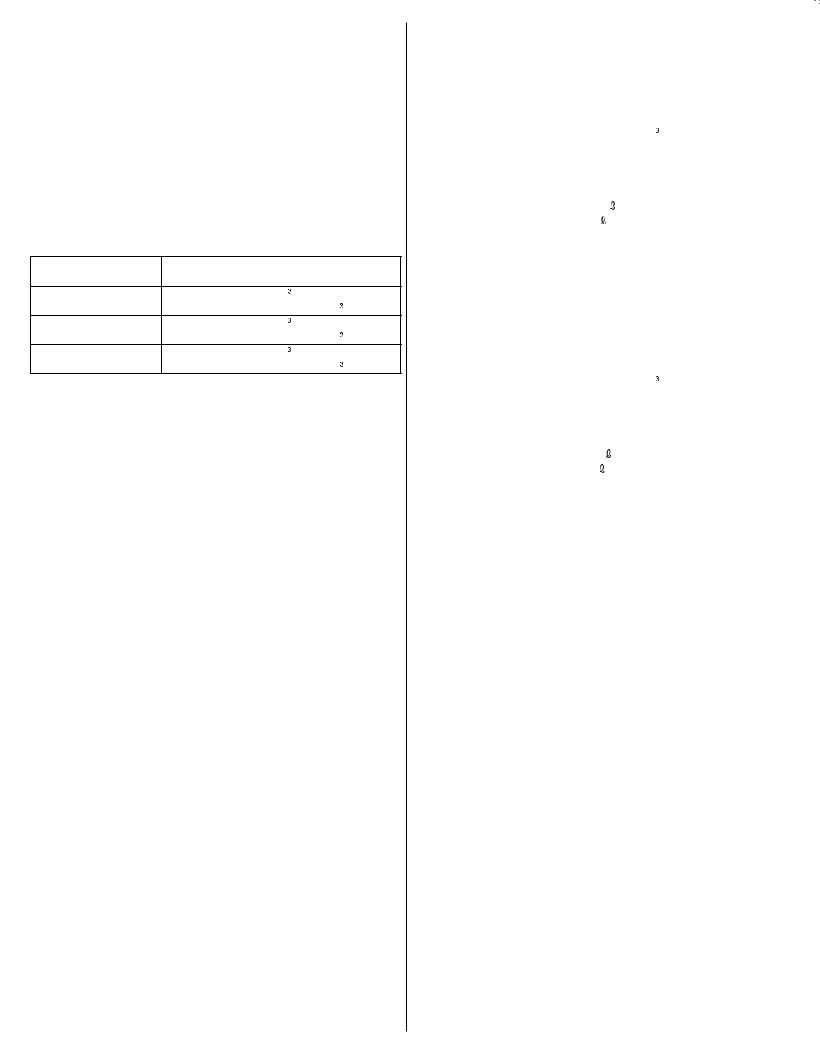
Air Index
An Air Index Information hang tag/label is applied to engines certified to an emission durability time period in accordance with the requirements of the California Air Resources Board.
The bar graph is intended to provide you, our customer, the ability to compare the emissions performance of available engines. The lower the Air Index, the less pollution.
The durability description is intended to provide you with information relating the engine’s emission durability period. The descriptive term indicates the useful life period for the engine’s emission control system. See your Emission Control System Warranty for additional information.
Descriptive Term |
Applicable to Emissions Durability |
|
|
Period |
|
Moderate |
50 hours [0 65 cm (0 65 cc)] |
|
|
125 hours [greater than 65 cm |
(65 cc)] |
Intermediate |
125 hours [0 65 cm (0 65 cc)] |
|
|
250 hours [greater than 65 cm |
(65 cc)] |
Extended |
300 hours [0 65 cm (0 65 cc)] |
|
|
500 hours [greater than 65 cm |
(65 cc)] |
The Air Index Information hang tag/label must remain on the engine until it is sold. Remove the hang tag before operating the engine.
Specifications
GXV340
Length × Width × |
|
433 × 382 × 406 mm |
|||
Height |
|
(17.0 × 15.0 × 16.0 in) |
|||
Dry weight |
|
31 kg (68 lbs) |
|||
Engine type |
|
4-stroke, overhead valve, single cylinder |
|||
Displacement |
|
338 cm |
(20.6 cu-in) |
||
[Bore × Stroke] |
|
[82 × 64 mm (3.2 × 2.5 in)] |
|||
Max. output |
|
8.2 kW (11 PS, 11 bhp) at 3,600 rpm |
|||
Max. torque |
|
24.0 N·m (2.45 kgf·m, 17.7 lbf·ft) |
|||
|
|
|
at 2,500 rpm |
||
Engine oil capacity |
|
1.10 (1.16 US qt , 0.97 Imp qt) |
|||
Fuel tank capacity |
|
2.3 (0.61 US gal , 0.51 Imp gal) |
|||
Fuel consumption |
|
313 g/kWh (230 g/PSh, 0.51 lb/hph) |
|||
Cooling system |
|
Forced air |
|||
Ignition system |
|
Transistorized magneto |
|||
PTO shaft rotation |
|
Counterclockwise |
|||
GXV390 |
|
|
|
|
|
Length × Width × |
|
433 × 382 × 406 mm |
|||
Height |
|
(17.0 × 15.0 × 16.0 in) |
|||
Dry weight |
|
32 kg (71 lbs) |
|||
Engine type |
|
4-stroke, overhead valve, single cylinder |
|||
Displacement |
|
389 cm |
(23.7 cu-in) |
||
[Bore × Stroke] |
|
[88 × 64 mm (3.5 × 2.5 in)] |
|||
Max. output |
|
9.7 kW (13 PS, 13 bhp) at 3,600 rpm |
|||
Max. torque |
|
27.5 N·m (2.8 kgf·m, 20.3 lbf·ft) at |
|||
|
|
|
2,500 rpm |
||
Engine oil capacity |
|
1.10 (1.16 US qt , 0.97 Imp qt) |
|||
Fuel tank capacity |
|
2.3 (0.61 US gal , 0.51 Imp gal) |
|||
Fuel consumption |
|
313 g/kWh (230 g/PSh, 0.51 lb/hph) |
|||
Cooling system |
|
Forced air |
|||
Ignition system |
|
Transistorized magneto |
|||
PTO shaft rotation |
|
Counterclockwise |
|||
Tuneup Specifications |
|
|
|||
ITEM |
|
SPECIFICATION |
|
MAINTENANCE |
|
Spark plug gap |
|
0.70 0.80 mm |
|
Refer to page: 10 |
|
|
|
(0.028 0.031 in) |
|
|
|
Idle speed |
|
1,400 ± 150 rpm |
|
See your |
|
Valve clearance |
|
IN: 0.15 ± 0.02 mm |
|
authorized |
|
(cold) |
|
EX: 0.20 ± 0.02 mm |
|
Honda dealer |
|
Other |
|
|
No other adjustments needed. |
||
specifications |
|
|
|
|
|
16 |
ENGLISH |
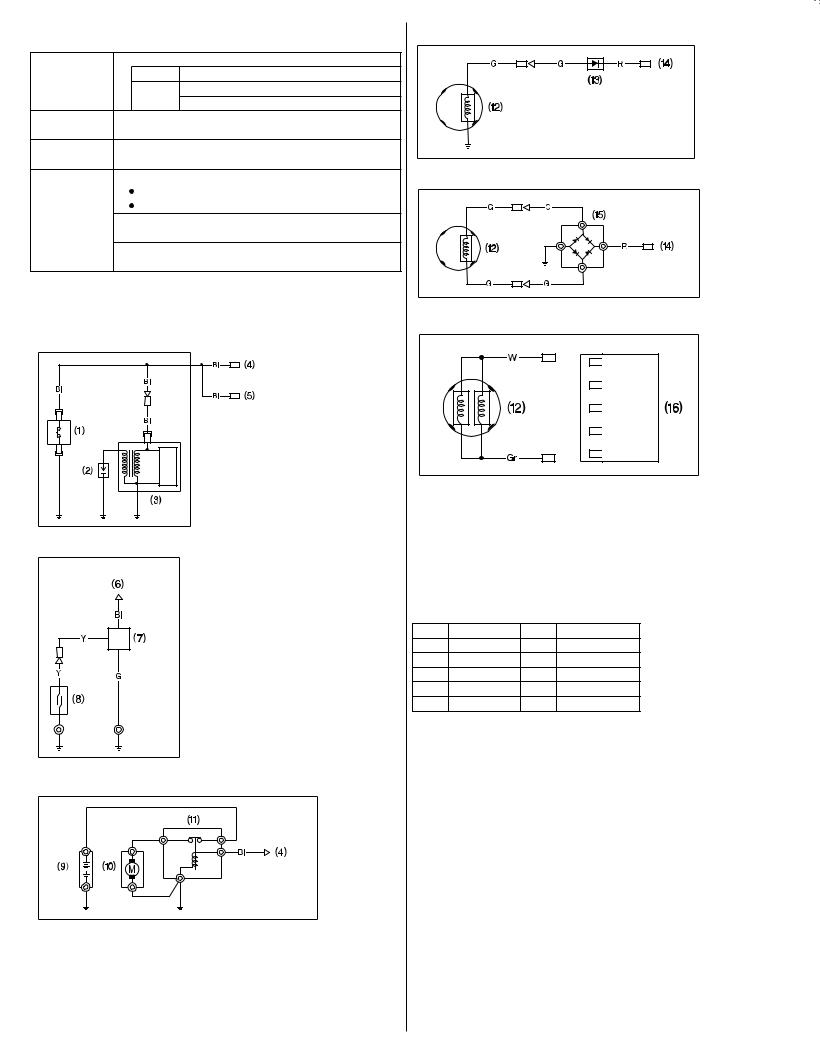
Quick Reference Information |
1A CHARGING SYSTEM |
||
Fuel |
Unleaded gasoline |
(Refer to page 8) |
|
|
U.S. |
Pump octane rating 86 or higher |
|
|
Except |
Research octane rating 91 or higher |
|
|
U.S. |
Pump octane rating 86 or higher |
|
Engine oil |
SAE 10W-30, API SJ or SL, for general use. |
||
|
Refer to page 8. |
|
|
Spark plug |
BPR5ES (NGK) |
|
|
|
W16EPR-U (DENSO) |
|
|
Maintenance |
Before each use: |
3A CHARGING SYSTEM |
|
|
Check engine oil level. Refer to page 9. |
||
|
Check air filter. Refer to page 10. |
||
|
First 20 hours: |
|
|
|
Change engine oil. Refer to page 9. |
||
|
Subsequent: |
|
|
|
Refer to the maintenance schedule on page 7. |
||
Wiring Diagrams |
|
|
|
|
|
|
10A CHARGING SYSTEM |
BASIC CIRCUIT |
|
|
|
|
(1) |
ENGINE STOP SWITCH |
|
(9) |
BATTERY (12 V) |
||
|
(2) |
SPARK PLUG |
|
|
(10) |
STARTER MOTOR |
|
|
(3) |
IGNITION COIL |
|
|
(11) |
STARTER SOLENOID |
|
OIL ALERT CIRCUIT |
(4) |
TO ENGINE SWITCH |
|
(12) |
CHARGING COIL |
||
|
(5) |
TO OIL ALERT CIRCUIT |
|
(13) |
DIODE |
||
|
(6) |
TO ENGINE STOP SWITCH |
(14) |
TO LOAD |
|||
|
(7) |
OIL ALERT BUZZER |
|
(15) |
RECTIFIER |
||
|
(8) |
OIL LEVEL SWITCH |
|
(16) |
REGULATOR |
||
|
Bl |
|
Black |
Br |
Brown |
|
|
|
Y |
|
Yellow |
O |
Orange |
|
|
|
Bu |
Blue |
Lb |
Light blue |
|||
|
G |
|
Green |
Lg |
Light green |
||
|
R |
|
Red |
P |
Pink |
|
|
|
W |
|
White |
Gr |
Gray |
|
|
12V STARTER CIRCUIT
ENGLISH |
17 |
